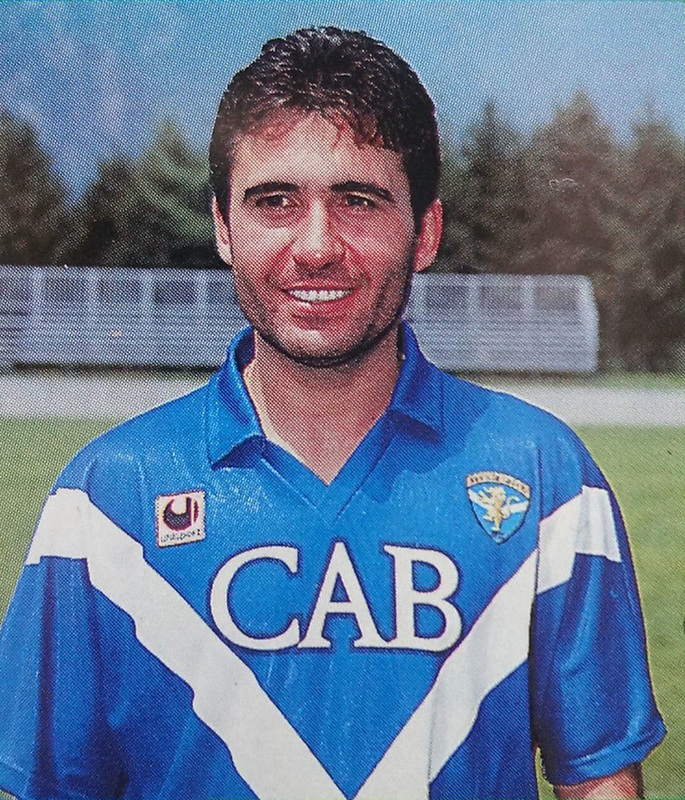It is hard to name many players who have sandwiched a quick jaunt at Italian club Brescia, between spells at Real Madrid and Barcelona. It is even more bizarre that one season of this was spent in Serie B and offered little more than a successful Anglo-Italian Cup campaign. Never the less in the early 1990’s Gheorghe Hagi did just this and swapped Spain, albeit momentarily, for the Italian Peninsula. Although not completely successful, this brief period allowed him to acquire cult status with the Biancoazzurri.
Managing to attract players of substantial ilk is somewhat of a speciality for Brescia. Roberto Baggio, Josep Guardiola and Andrea Pirlo have all walked the lush green boards of the Stadio Mario Rigamonti stage. Hagi and his Romanian compatriots arguably started this trend that would have made the ‘Rondinelle’ the hipsters club of choice (if hipsters had existed in the days preceding Italia 90). In this era coach Mircea Lucescu convinced President Luigi Corioni to trust him, as he brought a number of his compatriots to the club.
Whilst now this may seem like an odd choice, to flood a struggling Italian club with Romanians, it has to be taken in context. This was the era when the foreigners rule restricted teams to have only three on the pitch at the same time and Lucescu’s contemporaries were having success employing the same strategy. Milan had the three Dutchmen after all in Marco Van Basten, Ruud Gullit and Frank Rijkaard whilst Inter had had the German equivalent in Lothar Matthaus, Andreas Brehme and of course Jurgen Klinsmann.
So it came to be that Brescia looked East and to the Romanians for their inspiration. Hagi was the coup, there was no doubt of that, as somehow Corioni forged a deal with Madrid that brought the midfielder over for eight billion lire and amazingly what was believed to be a wage match. Here he joined his compatriots, Dorin Mateut who came from Real Zaragoza, he played only four times before leaving for a better spell at Reggiana. Florian Raducioiu, already based in Italy after spells with Bari and Hellas Verona also came across, he scored 13 times in 29 games for a team that would be relegated that year. This impressive stint saw him sign for Milan the following season and he would even return to the ‘Rondinelle’ in 1998. Finally, Ioan Sabau arrived from Feyenoord, the midfielder would play one game short of 100 for Brescia over four season and would also return to the club after a spell with Reggiana.
The two seasons Hagi exhibited his skills in Serie A were mixed. The first saw the team relegated after they lost a relegation playoff to Udinese. The Romanian superstar had scored five goals in that campaign but had not impressed. The midfielder was late for training and fined, he argued with the coach about his responsibilities in talking to the press but what was worse was that he was lazy. Whether he thought that being away from Real Madrid meant he could relax or the fact that he knew he was the best player in the team, left his anguished coach claiming that his stubborn and creative force, could be as good as Diego Maradona, if he wanted to be.
Lazy he may have been but disloyal he was not. Claiming he was ‘not a coward or a traitor’ he stayed with the club the following year and it was here when he became a star for them. It is very possible that Hagi had thought Serie A may have been easy after Madrid and the strength of the league perhaps surprised him but now in Serie B he had a field day. In 1994 Hagi won his only honours with the club, as despite the best efforts of Notts County goalkeeper Steve Cherry and front man Kevin Wilson, the Italians overcame them at Wembley for their silverware.
Whilst Hagi was certainly not a flat trap bully, he did up his game the next season. This was perhaps due to the fact that he may have realised he let his team down the season before, his intermittent displays only broken up by performances like that against Fiorentina that year. Now the Brescians really did see the ‘Maradona of the Carpathians’, his incredible passing range tearing holes in the opposition back lines. His confidence grew and grew and he scored nine times that year helping his team back to the top flight. His beautiful ability to skip past defenders and unleash ferocious shots only represented the strength of Serie B that year as Hagi (and the Viola’s Gabriel Batistuta) plied their trade with grace and vigour.
These performances eventually saw the Europe’s Elite come knocking again, they were simply that good. This time Barcelona came knocking and Hagi, one would hope to think reluctantly, said arrivederci to Serie A. It has been a brief and turbulent affair but it had been unforgettable and as Hagi went on to take the World Cup by storm in USA 94. In return the Brescians appetite had been wet (like the Neapolitans years earlier) for a continental superstar. When Calcio Ruled the World, Hagi was lazy, he was petulant but by God was he good.

